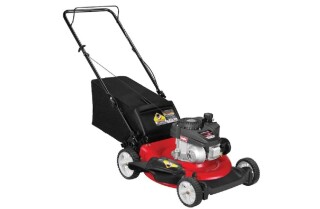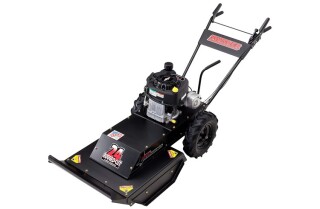The Best Tiller for Your Home Garden Needs
-
Craftsman 120V Electric Mini Tiller -
Mantis 7940 4-Cycle Gas Powered Tiller -
Earthwise Corded Electric Tiller -
Troy-Bilt TB154E Electric Tiller -
Buyer's Guide
Most suburban gardeners don't need the brute force and power of a gas-powered tiller. They need something lightweight, compact, and capable of tilling the soil in smaller household garden plots. That's exactly where an electric tiller comes in.
These best tillers in 2022 are capable of tilling the soil to a lesser depth and they won't break up extremely hard chunks of soil. The best picks on this list focus on being lightweight yet pack sufficient power and greater amperage. After all, weekend gardeners want to get in and get out of the garden as fast as possible, so we’ve included the best bang for the buck models too. Read on for our top picks and our buyer’s guide below.
Best Tillers of 2022 Reviewed in Detail

Craftsman 120V Electric Mini Tiller - Best Tiller Overall
At 22 pounds, the Craftsman 120V Electric Mini Tiller is one of the lightest tillers here. Perfect for small gardens, you can even remove a set of tines to go from a 10 inch tilling width to a six inch tilling width. That versatility makes it a decent tiller and a weeder for between the rows. It comes with a two year warranty, and only a five inch tilling depth. But with a middle of the road price, you would be hard pressed to find a better tiller for a smaller garden. It comes with a 6.5 amp motor and folding handles make for easy storage.
Mantis 7940 4-Cycle Gas Powered Tiller - Runner Up
Probably the best known tiller on the market is the Mantis Electric Tiller/Cultivator. This is a solid and well built tiller that is perfect for smaller garden or garden plot. It sports a five amp motor and weighs 21 pounds for easy maneuvering. It’s easily one of the most durable tillers here and comes with a five year warranty. This tiller has three speeds and tills down to 10 inches.
Although it may be the best overall tiller on the list, the short nine inch tilling width and the high price takes it out of the top spot. However, f you’re willing to pay the price, the Mantis can't be beat for smaller gardens.
Earthwise Corded Electric Tiller - Honorable Mention
The Earthwise TC70001 electric tiller features a powerful 8 1/2 amp motor, an 11 inch tilling width andweighs about 20 pounds. It’s light and maneuverable, yet gives you one of the widest cutting widths of any tiller featured here. A safety button engages the tines and it will till down as deep as eight inches.
Better still is the price since you get all of this for one of the lowest prices available.
The Earthwise TC70001 electric tiller is the best bang for the buck tiller around, with one of the largest blade widths and one of the most powerful motors on this list. No bells or whistles, just a tiller that will do your garden proud and it also comes with a two year warranty.
Troy-Bilt TB154E Electric Tiller - Consider
If you are looking for one of the most versatile tillers on the list, welcome to the Troy-Bilt (6-12") 6.5-Amp Electric Forward Rotating Front Tine Cultivator. Although it's rated as a 12 inch tiller, you can remove half the tines and use it as a six inch tiller. That allows you to get into places where others cannot go.
It's the heaviest tiller here, at 35 pounds, but gives you a bit more leverage when breaking up compacted soil. It has a three depth position adjustment, and will till down to eight inches deep. This is a good choice for smaller and medium sized gardens, with the added versatility of weeding between rows by removing one set of tines. It comes with a 2 year warranty.
Buyer's Guide
Tilling the soil for planting has been done as long as humans have been sowing seeds. The first manual tillers used were wooden sticks, with durable metal blades eventually added for increased effectiveness. Eventually, the blades were mounted and fixed in one position which allowed tillers to be pulled along by oxen and horses until the advent of steam engine powered units in 1857 and the first small engine gasoline-powered tiller in 1936.
Powered tillers were initially made with an engine mounted above a set of rotating tines, steered by a couple of crude handles. Granted, you would still have to spend some time muscling around a heavyweight unit, but the design allowed greater operator control and a tilling pace unmatched by either manual or animal-powered tilling.
Modern powered tillers are extremely useful machines for breaking up soil, tackling tough weeding, and even mixing compost into the soil before and after planting. For more information on the types of power sources driving these machines, you can refer to our lawn equipment power source buyer's guide which gives you a breakdown of what types are appropriate for your landscaping needs.
Tiller Types
Front Tines
Front tine tillers are the "do-it-all tillers" which are available in a wide variety of sizes suitable for virtually any garden plot out there. They may still have guide wheels at the back, but these aren’t powered and only serve to add stability when you’re tilling.
These tillers can be light enough to cultivate between garden rows or heavy enough to break up the soil on smaller-to-medium garden plots. They’re a bit more labor-intensive to use than rear tined varieties, but their size and lower weight make them extremely versatile.
There are some specialized front tine tillers available that have drive wheels and are made for huge gardens or acres of land, but for the most part, front tine tillers will work fine for the majority of light-to-medium-duty situations you’re likely to encounter.
Rear Tines
Rear tine tillers have drive wheels on the front which help pull the tiller along. This setup makes these tillers larger and bulkier, so they’re best used for larger plots of land. They're the easiest to use because you literally just hang on and steer while the wheels and tines do all the work.
Because the wheels make these units self-propelled (as well as having larger engines), they come larger and heavier than front tined models. These heavy-duty components make rear tine tillers perfect for large gardens or acres of land where you’ll need to break up tough, hard-packed soil.
Features
Adjustable Depth
On smaller mini-tillers, the depth is operator adjustable; the harder you push on the handles, the deeper the blades will dig into the soil. The adjustable depth is the height of the front axle above the ground which is typically about 4 inches deep.
On the front and rear tine tillers, the depth should be adjustable at the wheels by lowering or raising them, depending on how deep or shallow you want to till. Generally, higher-priced units will have height adjustments on a separate handle, while lower-priced models will have manual adjustments located on the wheels themselves.
Tires
The tires on a rototiller can either be solid, rubber, plastic, or air-filled pneumatic options. Guide wheels are almost always solid since all they need to do is to keep you on course. The best-powered drive wheels are pneumatic because they’ll adhere better to the terrain and cause less slippage during the tilling process.
Removable Tines
This feature is found mainly on front-drive tillers to add to their versatility. Removing specific tines will allow you to leave one or two on the unit to better cultivate and weed between rows. For example, you can remove the two inner tines on a four-tine tiller, allowing the center of the unit to safely pass over smaller plants while weeding or composting around them.
Counter Rotational Tines
These can be found on higher-end tillers which gives the operator a more aggressive, and therefore a more efficient, tiller. These are the best tine types for breaking up hard-packed soil, but these are also the heaviest units in their class due to the extra tines and mechanics needed to make them work efficiently.
What's Best for You
Small Gardens
The lightest in weight and the least expensive tillers are electrically powered. They’re all fairly light-duty and would be perfect for smaller gardens as long as you are within the recommended cord length of 100 feet. Small, gasoline-powered mini-tillers which are lightweight, and easy to maneuver are also suitable.
Most lighter-weight tillers can be used for weeding between the rows, as well as mulching and overall garden care. While these light-duty tillers won’t do break up extremely hardened soil, they’re good for regular spring tilling of established soil.
Medium Gardens
Front tined tillers work best here in medium-sized garden settings; those with removable tines are especially useful as they can be converted to till between rows. Since front tined tillers are a bit more labor-intensive, operator fatigue tends to set in a little sooner. However, for most homeowners with somewhat larger gardens or areas of land to till, these would be the best types to consider.
Large Gardens or Plots of Land
Rear tined units are made for large gardens or large plots of land. They have the capability of chopping through hardened dirt and will run and work as long as you can. Although some of these units may have removable tines, rear-tined units are generally much too heavy-duty for anything but the most extreme tilling jobs. The larger engines and the overall increased weight make them a better bet for going in straight lines over multiple acres of land. Realistically, they could till acres of land with the least amount of operator fatigue, but if you have that much land, a tractor-driven tiller would be a more sensible investment.













